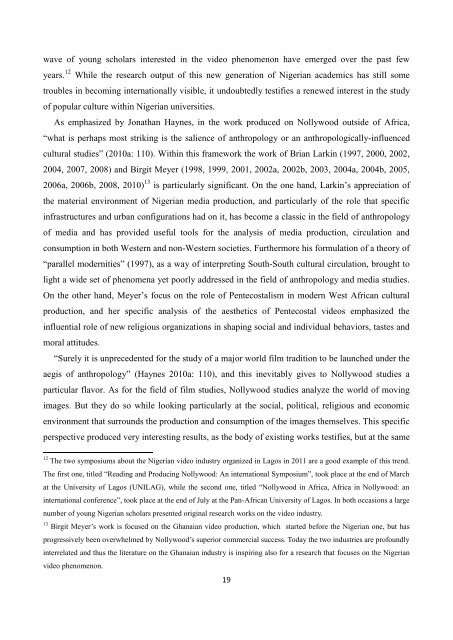You also want an ePaper? Increase the reach of your titles
YUMPU automatically turns print PDFs into web optimized ePapers that Google loves.
wave of young scholars interested in the video phenomenon have emerged over the past fewyears. 12 While the research output of this new generation of Nigerian academics has still sometroubles in becoming internationally visible, it undoubtedly testifies a renewed interest in the studyof popular culture within Nigerian universities.As emphasized by Jonathan Haynes, in the work produced on Nollywood outside of Africa,“what is perhaps most striking is the salience of anthropology or an anthropologically-influencedcultural studies” (2010a: 110). Within this framework the work of Brian Larkin (1997, 2000, 2002,2004, 2007, 2008) and Birgit Meyer (1998, 1999, 2001, 2002a, 2002b, 2003, 2004a, 2004b, 2005,2006a, 2006b, 2008, 2010) 13 is particularly significant. On the one hand, Larkin’s appreciation ofthe material environment of Nigerian media production, and particularly of the role that specificinfrastructures and urban configurations had on it, has become a classic in the field of anthropologyof media and has provided useful tools for the analysis of media production, circulation andconsumption in both Western and non-Western societies. Furthermore his formulation of a theory of“parallel modernities” (1997), as a way of interpreting South-South cultural circulation, brought tolight a wide set of phenomena yet poorly addressed in the field of anthropology and media studies.On the other hand, Meyer’s focus on the role of Pentecostalism in modern West African culturalproduction, and her specific analysis of the aesthetics of Pentecostal videos emphasized theinfluential role of new religious organizations in shaping social and individual behaviors, tastes andmoral attitudes.“Surely it is unprecedented for the study of a major world film tradition to be launched under theaegis of anthropology” (Haynes 2010a: 110), and this inevitably gives to Nollywood studies aparticular flavor. As for the field of film studies, Nollywood studies analyze the world of movingimages. But they do so while looking particularly at the social, political, religious and economicenvironment that surrounds the production and consumption of the images themselves. This specificperspective produced very interesting results, as the body of existing works testifies, but at the same12 The two symposiums about the Nigerian video industry organized in Lagos in 2011 are a good example of this trend.The first one, titled “Reading and Producing Nollywood: An international Symposium”, took place at the end of Marchat the University of Lagos (UNILAG), while the second one, titled “Nollywood in Africa, Africa in Nollywood: aninternational conference”, took place at the end of July at the Pan-African University of Lagos. In both occasions a largenumber of young Nigerian scholars presented original research works on the video industry.13 Birgit Meyer’s work is focused on the Ghanaian video production, which started before the Nigerian one, but hasprogressively been overwhelmed by Nollywood’s superior commercial success. Today the two industries are profoundlyinterrelated and thus the literature on the Ghanaian industry is inspiring also for a research that focuses on the Nigerianvideo phenomenon.19
















